TRANSPORTATION IN THE ROMAN EMPIRE
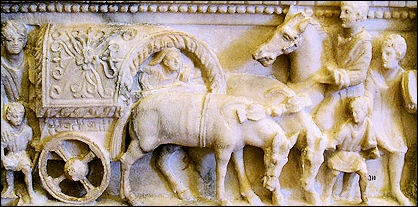
Travel on the sea was generally more comfortable that over land. Road travel was either on foot or in springless carriages, carts or chariots that bounced and bumped over every cobblestone. Egyptians, Hittites, Aryans, Shang Dynasty Chinese and Assyrians had chariots long before the Greeks and Romans did.
Harold Whetstone Johnston wrote in “The Private Life of the Romans”: “For our knowledge of the means of traveling employed by the Romans we have to rely upon indirect sources, because, if any books of travel were written by Romans they have not come down to us. We know, however, that while no distance was too great to be traversed, no hardships too severe to be surmounted, the Roman in general cared little for travel in itself, for the mere pleasure, that is, of sight-seeing as we enjoy it now. This was partly due to his blindness to the charms of nature in its wilder aspects, more perhaps to the feeling that to be out of Rome was to be forgotten. He made once in his life the grand tour, when he visited famous cities and strange or historic sites; he spent a year abroad, in the train of some general or governor, but, this done, only the most urgent private affairs or public duties could draw him from Italy. [Source: “The Private Life of the Romans” by Harold Whetstone Johnston, Revised by Mary Johnston, Scott, Foresman and Company (1903, 1932) forumromanum.org |+|]
“And Italy meant to him only Rome and his country estates. These he visited when the hot months had closed the courts and adjourned the senate; he roamed restlessly from one estate to another, enjoying the beauty of the Italian landscape, but impatient for his real life to begin again. Even when public or private business called him from Rome, he kept in touch with affairs by correspondence; he expected his friends to write him voluminous letters, and was ready himself to return the favor when positions should be reversed. So, too, the proconsul kept as near to Rome as the boundaries of his province would permit.
“The lack of public conveyances running on regular schedules makes it impossible to tell the speed ordinarily made by travelers. Speed depended upon the total distance to be covered, the degree of comfort demanded by the traveler, the urgency of his business, and the facilities at his command. Cicero speaks of fifty-six miles in ten hours by cart as something unusual, but on Roman roads it ought to have been possible to go much faster, if fresh horses were provided at the proper distances, and if the traveler could stand the fatigue. The sending of letters gives the best standard of comparison. There was no public postal service, but every Roman of position had among his slaves special messengers (tabellarii), whose business it was to deliver important letters for him. They covered from twenty-six to twenty-seven miles on foot in a day, and from forty to fifty in carts. We know that letters were sent from Rome to Brundisium, 370 miles, in six days, and on to Athens in fifteen more. A letter from Sicily would read Rome on the seventh day, from Africa on the twenty-first day, from Britain on the thirty-third day, and from Syria on the fiftieth day. In the time of Washington it was no unusual thing for a letter to take a month to go from the eastern to the southern states in winter. “|+|
Categories with related articles in this website: Early Ancient Roman History (34 articles) factsanddetails.com; Later Ancient Roman History (33 articles) factsanddetails.com; Ancient Roman Life (39 articles) factsanddetails.com; Ancient Greek and Roman Religion and Myths (35 articles) factsanddetails.com; Ancient Roman Art and Culture (33 articles) factsanddetails.com; Ancient Roman Government, Military, Infrastructure and Economics (42 articles) factsanddetails.com; Ancient Greek and Roman Philosophy and Science (33 articles) factsanddetails.com; Ancient Persian, Arabian, Phoenician and Near East Cultures (26 articles) factsanddetails.com
Websites on Ancient Rome: Internet Ancient History Sourcebook: Rome sourcebooks.fordham.edu ; Internet Ancient History Sourcebook: Late Antiquity sourcebooks.fordham.edu ; Forum Romanum forumromanum.org ;
“Outlines of Roman History” forumromanum.org; “The Private Life of the Romans” forumromanum.org|; BBC Ancient Rome bbc.co.uk/history; Perseus Project - Tufts University; perseus.tufts.edu ; Lacus Curtius penelope.uchicago.edu;
Gutenberg.org gutenberg.org
The Roman Empire in the 1st Century pbs.org/empires/romans;
The Internet Classics Archive classics.mit.edu ;
Bryn Mawr Classical Review bmcr.brynmawr.edu;
De Imperatoribus Romanis: An Online Encyclopedia of Roman Emperors roman-emperors.org;
British Museum ancientgreece.co.uk; Oxford Classical Art Research Center: The Beazley Archive beazley.ox.ac.uk ;
Metropolitan Museum of Art metmuseum.org/about-the-met/curatorial-departments/greek-and-roman-art;
The Internet Classics Archive kchanson.com ;
Cambridge Classics External Gateway to Humanities Resources web.archive.org/web; Internet Encyclopedia of Philosophy iep.utm.edu;
Stanford Encyclopedia of Philosophy plato.stanford.edu;
Ancient Rome resources for students from the Courtenay Middle School Library web.archive.org ;
History of ancient Rome OpenCourseWare from the University of Notre Dame /web.archive.org ;
United Nations of Roma Victrix (UNRV) History unrv.com
Land Travel in the Roman Empire
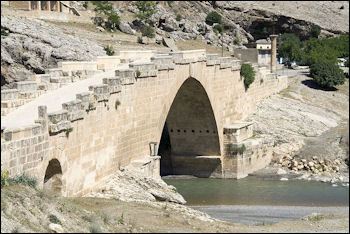
Roman bridge in Turkey Harold Whetstone Johnston wrote in “The Private Life of the Romans”: “
The Roman who traveled by land was distinctly better off than Americans of the time of the Revolution. His inns were not so good, it is true, but his vehicles and horses were fully equal to theirs, and his roads were the best that have been built until very recent times. Horseback riding was not a recognized mode of traveling (the Romans had no saddles), but there were vehicles, covered and uncovered, with two wheels and with four, for one horse and for two or more. These were kept for hire outside the gates of all important towns, but the price is not known. To save the trouble of loading and unloading the baggage it is probable that persons going great distances took their own vehicles and merely hired fresh horses from time to time. [Source: “The Private Life of the Romans” by Harold Whetstone Johnston, Revised by Mary Johnston, Scott, Foresman and Company (1903, 1932) forumromanum.org |+|]
“There were, however, no post-routes and no places where horses were changed at the end of regular stages for ordinary travelers, though there were such arrangements for couriers and officers of the government, especially in the provinces. For short journeys and when haste was not necessary, travelers would naturally use their own horses as well as their own carriages. Of the pomp which often accompanied such journeys. |+|
“The streets of Rome were so narrow that wagons and carriages were not allowed upon them at hours when they were likely to be thronged with people. Through many years of the Republic, and for at least two centuries afterwards, the streets were closed to all vehicles during the first ten hours of the day, with the exception of four classes only: market wagons, which brought produce into the city by night and were allowed to leave empty the next morning, transfer wagons (plaustra) conveying material for public buildings, the carriages used by the Vestals, flamines, and rex sacrorum in their priestly functions, and the chariots driven in the pompa circensis and in triumphal processions. Similar regulations were in force in almost all Italian towns. This, in imperial times, made general the use within the walls of the lectica and its bearers. (See illustration in Walters under lectica, and Sandys, Companion, page 209.) Besides the litter in which the passenger reclined, a sedan chair in which he sat erect was common. Both were covered and curtained. The lectica was sometimes used for short journeys, and in place of the six or eight bearers, mules were sometimes put between the shafts, one before and one behind, but not until late in the Empire. Such a litter was called basterna. |+|
Road Travel in the Roman Empire
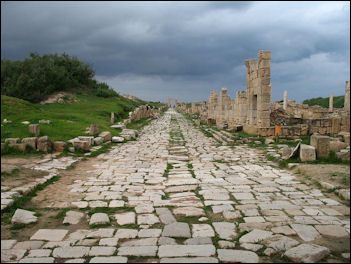
Road at Leptis Magna in Libya
Most traffic — soldiers, chariots, animals, carts, pedestrians — moved pretty slowly. Milestones inscribed with various kinds of information, such as distance to the next town, marked the Roman miles (measurements of 1,620 yards) on the major Roman roads.
By examining ruts left by cart and carriage wheels in the stone streets, archaeologists have surmised the Romans had one way streets and no-left-turn intersections. National Geographic writer James Cerruti had always wondered whether Roman carts and carriages drove on the right side of the road or the left side. When he saw grooves in the a section of the ancient Appian Way he realized they drove the same way Italians often do today: straight down the middle."
The Roman empire's major highway was the Via Salaria (Salt Road), on which salt was carried from the salt pans of Ostia to Rome. The Via Domitia connected Italy to Spain, the Via Egnatia linked Rome to Byzantium. An eastward extension of the Via Egnatia, the famed road to Damascus, ran across Turkey and southward to Beruit and Syria.
The Roman armies built pontoon bridges to move across waterways and used horses to scout out the enemy on reconnaissance missions. Trajan built a great bridge across the Danube, a startling achievement for its times, to aid his conquest of Dacia The bridge and battles from the Dacian campaign are immortalized in 200 meters of scenes that spiral around the 100-foot-high Trajan column. Trajan's bridge was torn down by Hadrian who felt that it might facilitate a Barbarian conquest of Rome.
Local people needed passport to travel on the official routes. There were no real addresses. Few streets had names and those that did didn't have signs or numbers. Messengers could cover a distance of about 200 miles a day by on main roads by changing horses every 10 miles or so, pony express-style. Traveling in this fashion it took only about six days to reach Britain from Rome (a record that was not improved upon until the invention of modern automobiles in the 20th century).
Roads in the Roman Empire
The Romans built over 53,000 miles of paved roads, stretching from Scotland to East Europe to Mesopotamia in present-day Iraq to North Africa. It was the greatest system of highways that the world has ever seen until recent times. Roman roads were built primarily to facilitate the movement of troops and supplies. Roman legionnaires would not have been nearly as effective in their conquests if getting them supplies was difficult. The system was so well set up that commanders could accurately calculate how long it would take to get their armies from one place to another: from Cologne to Rome was 67 days, Rome to Brindisis, 57 days, and Rome to Syria (including two days at sea), 124 days. [Source: "History of Warfare" by John Keegan, Vintage Books]
The Romans didn't make the first paved roads. The Assyrians built the first aqueducts and paved roads. But Roman roads certainly stood the test of time. The route the German Blitzkrieg used to move into France in 1940 through the Ardennes forests and over the River Meuse more or less followed Route Nationale 43 , which in turn followed the old Roman road laid out not long after Caesar's conquest of Gaul in the first century B.C. [Source: "History of Warfare" by John Keegan, Vintage Books]
Roman roads radiated out from a golden milestone in the Forum in Rome. The first road, the Appian Way (Via Appian), was built from Rome to Capua in 312 B.C. to connect Rome with its colonies on the Adriatic. Other roads crossed the Alps, linked Europe to Asia and traversed sections of the Sahara. Major routes were linked to ports. In A.D. 21, under the orders of Augustus, a map of the world based on the empire's road system was produced and displayed near the Forum in Rome. An inscription on a milestone of the Via Salaria reads: “Erected by the consul [117 B.C.] Lucius Caecilius Metellus, etc. One hundred nineteen (miles) from Rome.”
Harold Whetstone Johnston wrote in “The Private Life of the Romans”: “The engineering skill of the Romans and the lavish outlay of money made their roads the best that the world has known until very recent times. They were strictly military works, built for strategic purposes, intended to facilitate the dispatching of supplies to the frontier and the massing of troops in the shortest possible time. Beginning with the first important acquisition of territory in Italy (the Via Appia was built in 312 B.C.) they kept pace with the expansion of the Republic and the Empire, so that a great network of roads covered the Roman world, all indeed leading to Rome, as the proverb has it. In Britain, for instance, the roads, some of which are still in use, converged at Londinium (London). [Source: “The Private Life of the Romans” by Harold Whetstone Johnston, Revised by Mary Johnston, Scott, Foresman and Company (1903, 1932) forumromanum.org |+|]

Road with chariot ruts “They ran as far north as the wall of Antoninus Pius, and out to points on the coast. After crossing the Channel one found the highway again as it may still be traced, running down through Gaul and on to Rome. In the fourth century of our era nineteen great roads, it is said, went out from Rome through the fifteen gates of the Wall of Aurelian. In Italy roads were built at the cost of the State; in the provinces the conquered communities bore the expense of construction and maintenance, but the work was done under the direction of Roman engineers, and often by the legions between campaigns. Roads ran in lines as straight as possible between the towns they were to connect, with frequent crossroads and branch roads only less carefully constructed. The grade was always easy, because hills were cut through, gorges and rivers were crossed on arches of solid stone, and valleys and marshes were spanned by viaducts of the same material. |+|
“The surface of the roads was rounded, and there were gutters at the sides to carry off rain and melted snow. Milestones showed the distance from the starting-point of the road and often that to important places in the opposite direction, as well as the names of the consuls or emperors under whom the roads were built or repaired. The roadbed was wide enough to permit the meeting and passing, without trouble, of the largest wagons. For the pedestrian there was a footpath on either side, sometimes paved, and seats for him to rest upon were often built by the milestones. The horseman found blocks of stone set here and there for his convenience in mounting and dismounting. Where springs were discovered, wayside fountains for men and watering-troughs for cattle were constructed. Such roads often went a hundred years without repairs, and some portions of them have endured the traffic of centuries and are still in good condition today.
Construction of Roads
Roman all-weather roads were built with a great degree of sophistication. There were three levels of substructure under the roads, which bulged slightly at the center to allow rainwater to run off them. On steep hills grooves were notched in the road so that people and horses could descend without slipping.
Harold Whetstone Johnston wrote in “The Private Life of the Romans”: “Our knowledge of the construction of the military roads is derived from a treatise of Vitruvius on pavements and from existing remains of the roads themselves. The Latin phrase for building a road, munire viam, epitomizes the process exactly, for munire means “to build a wall” (moenia); and throughout its full length, whether carried above the level of the surrounding country or in a cut below it, the road was a solid wall averaging fifteen feet in width and perhaps three feet in height. A cut (fossa) was first made of the width of the intended road and of a depth sufficient to hold the filling, which varied with the nature of the soil. The earth at the bottom of the cut (E) was leveled and made solid with heavy rammers. Upon this was spread the statumen (D), a foundation course of stones not too large to be held in the hand; the thickness of the layer varied with the porosity of the soil. Over this came the rudus (C), a nine inch layer of coarse concrete or rubble made of broken stones and lime. Over this was laid the nucleus (B), a six-inch bedding of fine concrete made of broken potsherds and lime, in which was set the final course (A) of blocks of lava or of other hard stone furnished by the adjacent country. This last course (dorsum) made the roadway (agger viae) and was laid with the greatest care so as to leave no seams or fissures to admit water or to jar the wheels of vehicles. In the diagram the stones are represented with the lower surface flat, but they were commonly cut to a point or edge in order to be held more firmly by the nucleus. The agger was bounded on the sides by umbones (G, G), curbstones beyond which lay the footpaths (F, F), semitae or margines. On a subsoil of rocky character the foundation course or even the first and second courses might be unnecessary. On the less traveled branch roads the agger seems to have consisted of a thick course of gravel (glarea), well rounded and compacted, instead of the blocks of stone, and the crossroads may have been of still cheaper materials.” [Source: “The Private Life of the Romans” by Harold Whetstone Johnston, Revised by Mary Johnston, Scott, Foresman and Company (1903, 1932) forumromanum.org |+|]

Adam Hart-Davis wrote for the BBC: “In order to move the army quickly across the country, the Romans built tremendous roads. I had always been told that Roman roads are straight, but I really had this rubbed in on the A68 north of Corbridge, where the road goes in a dead straight line for miles over the rolling hills. In fact it's rather dangerous for driving; because it is so straight you are tempted to drive fast. Nothing in the Roman world did more than say 20 m.p.h. (a galloping horse) and they built their roads up and down steep hills - sometimes as much as 1 in 6. The result is that not only are there some fierce hills to climb, but often there are blind summits, where you can't see oncoming traffic even 50 yards away. So if you drive too fast and try to overtake you are liable to meet someone else coming the other way. [Source: Adam Hart-Davis, BBC, February 17, 2011 |::|]
“Building roads in a straight line is not difficult - you merely have to plant two canes in the ground, walk ahead and plant a third in line with the first two, and so on. Sighting along canes gives good straight lines for miles. However, what really impressed me was how they managed to set off in the right direction. For example, when the Romans wanted to build a road from London to Chichester, they knew exactly where to head for, even though the distance is 65 miles, there are several hills in the way and they had neither maps nor compasses. |::|
“There's an old saying 'I hear and I forget; I see and I remember; I do and I understand.' Roman road surveying was just like this for me. I learned and understood how to do it by surveying a route over high sand dunes from one flag to another that I could not see. I knew roughly which way to go; so I went to the high point on a sand dune not far from the route and put a beacon there. Then I walked on and planted another beacon at the next high point, from where I could see the goal. I went back to the first beacon and moved it to the straight line between the first flag and the second beacon by using a groma. |::|
“The groma was the standard Roman surveyor's instrument. It's an upright stick with a couple of bits of wood fixed to the top to make a cross. From each end of the cross hangs a little weight on a string. When the groma is stuck in the ground you stand behind it and twist it until you can sight along two of the strings to the starting point. Then you walk around the groma and sight the other way, to the second beacon. If the strings do not line up with the beacon then you move the beacon beside you in order to get more in line. Plant the beacon, plant the groma, and try again, until the strings line up with the start point in one direction and with the second beacon in the other. Then you know that the start point and the first two beacons are all in one line. |::|
“Repeat the whole process with the second beacon, then with the first again, and the second again, until the start point, the finish point, and both beacons are in the same line. This process would be much more efficient if one surveyor were standing at each beacon, ready to move it - and even better if they all had mobile phones! |::|
Appian Way
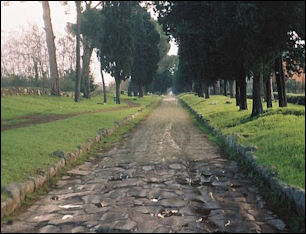
Via Appia The Appian Way is one of ancient Rome's most famous roads. It extends for ten miles within the city limits of Rome beginning at the Colosseum and heads southeast. Begun in 312 B.C. under orders of the Republican magistrate Appius Clauduius, it once extended 370 miles Brindisi and was the major transport route to Greece and the eastern Mediterranean. Along the way you can still find patches of huge, green-gray volcanic stones, called selces , that the Romans paved with, and kiln-shaped Roman tombs with classical entrances. Rich Romans had their tombs placed here in the belief that exposure to the thousand of people that traveled the Appian Way wound grant them immortality.
To the north of Terracina (about 50 miles southeast of Rome) the Romans built the Appian Way on a bed of rubble through a 30 mile section of marsh, an incredible engineering feat for its the time. Few other ancient people knew how to build road beds let alone in swamp. In another incredible undertaking Romans cut through 121 foot rock outcrop with only chisels and picks at Trojan's Cut. If you visit the sight you can still see Roman numerals that were used to mark the depth of the passageway.
Minturnae (about 100 miles southwest of Rome) boasts one of the more complete sets of Roman ruins along the Appian Way. The section of the Roman road here which consists of coffee table-sized cobblestones is in very good condition as are the remains of the forum, aqueduct, theater, and temple. In the ancient Roman bath there is a mosaic that shows a bunch of winged cupids stomping grapes into wine. Not too far from Minturnae is a massive 21 arch viaduct-Ponte degli Aurunci-that withstood the weight of tanks in World War and still supports traffic today.
Other Interesting Appian Towns include Alberobello (about 50 miles southeast of Bari), whose houses have stone beehive roofs, used to direct infrequent rains into underground cisterns; Gravina di Puglia (about 60 miles northwest of Taranto), a rugged little village built among rocky hills chilled by forested canyons; Ordona (between Bari and Benevento) which boasts the foundations of a grand temple, as well as an ancient bath and shops; and Egnazia (between Bari and Brindisi), an ancient resort on the Adriatic Sea, where a section of the Appia still contains the grooves of cart, carriage and chariot wheels; and the port town of Bari.
Roman Military Infrastructure and Roads
The Roman armies built pontoon bridges and used horses to scout out the enemy on reconnaissance missions. During military campaigns officers stayed in tents outfit with floor and even couches and soldiers slept in tents called papiliones that opened from a cocoon-like roll into a tent with flaps that resembled a butterfly. [Source: Timothy Foote, Smithsonian, April 1985]
Flavius Vegetius Renatus (died A.D. 450) wrote in “De Re Militari”: “The legion carries with it a number of small boats, each hollowed out of a single piece of timber, with long cables and sometimes iron chains to fasten them together. These boats, joined and covered with planks, serve as bridges over unfordable rivers, on which both cavalry and infantry pass without danger. The legion is provided with iron hooks, called wolves, and iron scythes fixed to the ends of long poles; and with forks, spades, shovels, pickaxes, wheelbarrows and baskets for digging and transporting earth; together with hatchets, axes and saws for cutting wood. Besides which, a train of workmen attend on it furnished with all instruments necessary for the construction of tortoises, musculi, rams, vines, moving towers and other machines for the attack of places. As the enumeration of all the particulars of this sort would be too tedious, I shall only observe that the legion should carry with it wherever it moves, whatever is necessary for every kind of service so that the encampments may have all the strength and conveniences of a fortified city. [Source: De Re Militari (Military Institutions of the Romans) by Flavius Vegetius Renatus (died A.D. 450), written around A.D. 390. translated from the Latin by Lieutenant John Clarke Text British translation published in 1767. Etext version by Mads Brevik (2001) digitalattic.org]

Roman roads in Britain
Arms factories positioned along the roads kept the Roman armies supplied with iron armor, helmets, swords and javelins. The production of weapons was considered so important that arms factory workers were branded "as a deterrent against desertion. " [Keegan, Op. cit."
Roads were crucial to the movement of troops and supplies. The legionnaires would not have been nearly as effective in their conquest if getting them supplies was difficult. The system was so well set up that commanders could accurately calculate how long it would take to get their armies from one place to another: from Cologne to Rome was 67 days, Rome to Brindisis, 57 days, and Rome to Syria (including two days at sea), 124 days. [Keegan]
Using its network of military roads, armies and munitions of war could be sent into almost very part of the Roman Empire. The first military road was the Appian Way (via Appia), built by Appius Claudius during the Samnite wars. It connected Rome with Capua, and was afterward extended to Beneventum and Venusia, and finally as far as Brundisium. This furnished a model for the roads which were subsequently laid out to other points in Italy. The Latin Way (via Latina) ran south into the Samnite country and connected with the Appian Way near Capua and at Beneventum. The Flaminian Way (via Flaminia) ran north through eastern Etruria and Umbria to Ariminum. From this last-mentioned place, the Aemilian Way (via Aemilia) extended into Cisalpine Gaul as far as Placentia on the river Po. Another important road, the Cassian Way (via Cassia) ran through central Etruria to Arretium, and connected with the Aemilian Way in Cisalpine Gaul. Along the western coast of Etruria ran the Aurelian Way (via Aurelia). These were the chief military roads constructed during the time of the republic. So durable were these highways that their remains exist to the present day. [Source: “Outlines of Roman History” by William C. Morey, Ph.D., D.C.L. New York, American Book Company (1901), forumromanum.org]
Passages of Rivers by the Roman Military
Flavius Vegetius Renatus (died A.D. 450) wrote in “De Re Militari”: “The passages of rivers are very dangerous without great precaution. In crossing broad or rapid streams, the baggage, servants, and sometimes the most indolent soldiers are in danger of being lost. Having first sounded the ford, two lines of the best mounted cavalry are ranged at a convenient distance entirely across the river, so that the infantry and baggage may pass between them. The line above the ford breaks the violence of the stream, and the line below recovers and transports the men carried away by the current. When the river is too deep to be forded either by the cavalry or infantry, the water is drawn off, if it runs in a plain, by cutting a great number of trenches, and thus it is passed with ease. [Source: De Re Militari (Military Institutions of the Romans) by Flavius Vegetius Renatus (died A.D. 450), written around A.D. 390. translated from the Latin by Lieutenant John Clarke Text British translation published in 1767. Etext version by Mads Brevik (2001) digitalattic.org]
“Navigable rivers are passed by means of piles driven into the bottom and floored with planks; or in a sudden emergency by fastening together a number of empty casks and covering them with boards. The cavalry, throwing off their accoutrements, make small floats of dry reeds or rushes on which they lay their rams and cuirasses to preserve them from being wet. They themselves swim their horses across the river and draw the floats after them by a leather thong.
“But the most commodious invention is that of the small boats hollowed out of one piece of timber and very light both by their make and the quality of the wood. The army always has a number of these boats upon carriages, together with a sufficient quantity of planks and iron nails. Thus with the help of cables to lash the boats together, a bridge is instantly constructed, which for the time has the solidity of a bridge of stone.
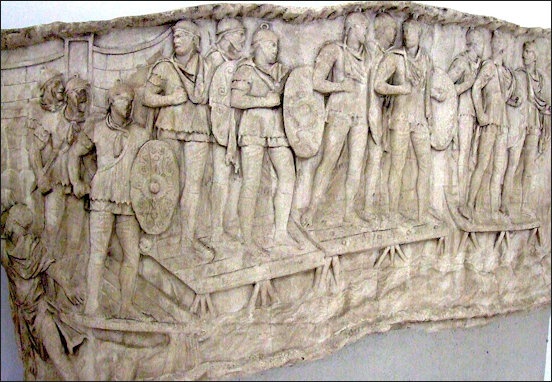
Engineering corps river crossing
“As the enemy generally endeavor to fall upon an army at the passage of a river either by surprise or ambuscade, it is necessary to secure both sides thereof by strong detachments so that the troops may not be attacked and defeated while separated by the channel of the river. But it is still safer to palisade both the posts, since this will enable you to sustain any attempt without much loss. If the bridge is wanted, not only for the present transportation of the troops but also for their return and for convoys, it will be proper to throw up works with large ditches to cover each head of the bridge, with a sufficient number of men to defend them as long as the circumstances of affairs require.
Ancient Roman Inns
Harold Whetstone Johnston wrote in “The Private Life of the Romans”: “There were numerous lodging houses and restaurants in all the cities and towns of Italy, but all were of the meanest character. Respectable travelers avoided them scrupulously; they either had stopping-places of their own (deversoria) on roads that they used frequently, or claimed entertainment from friends and hospites, whom they would be sure to have everywhere. Nothing but accident, stress of weather, or unusual haste could drive them to places of public entertainment (tabernae deversoriae, cauponae). [Source: “The Private Life of the Romans” by Harold Whetstone Johnston, Revised by Mary Johnston, Scott, Foresman and Company (1903, 1932) forumromanum.org |+|]
“The guests of such places were, therefore, of the lowest class, and innkeepers (caupones) and inns bore the most unsavory reputations. Food and beds were furnished the travelers, and their horses were accommodated under the same roof and in unpleasant proximity. The plan of an inn at Pompeii may be taken as a fair sample of all such houses. The entrance (a) is broad enough to admit wagons into the wagon-room (f), behind which is the stable (k). In one corner is a watering-trough (l), in another a latrina (i). On either side of the entrance is a wine-room (b, d), with the room of the proprietor (c) opening off one of them. The small rooms (e, g, h) are bedrooms, and other bedrooms in the second story over the wagon-room were reached by the back stairway.
“The front stairway has an entrance of its own from the street; the rooms reached by it had probably no connection with the inn. Behind this stairway on the lower floor was a fireplace (m) with a water heater. An idea of the moderate prices charged in such places may be had from a bill which has come down to us in an inscription preserved in the Museum at Naples: a pint of wine with bread, one cent; other food, two cents; hay for a mule, two cents. The corners of streets, especially at points close to the city walls, were the favorite sites for inns, and they had signs (the elephant, the eagle, etc.) like those of much later times.” Innkeepers inscribed wine lists and prices on the wall of their facilities. |+|
Carriages
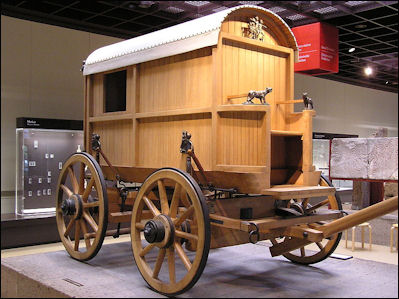
Roman stagecoach Harold Whetstone Johnston wrote in “The Private Life of the Romans”: “The monuments show us rude representations of several kinds of vehicles and the names of at least eight have come down to us, but we are not able positively to connect the representations and the names, and have, therefore, only very general notions of the form and construction of even the most common. Some, of ancient design, were retained wholly, or chiefly, for use as state carriages in the processions that have been mentioned. Such were the pilentum and the carpentum, the former with four wheels, the latter with two, both covered, both drawn by two horses, both used by the Vestals and priests. The carpentum is rarely spoken of as a traveling carriage; its use for such a purpose was a mark of luxury. According to Livy, the first Tarquin came from Etruria to Rome in a carpentum.The petoritum also was used in the triumphal processions, but only for the spoils of war. It was essentially a baggage wagon and was occupied by the servants in a traveler’s train. The carruca was a luxurious traveling van, of which we hear first in the late Empire. It was furnished with a bed on which the traveler reclined by day and slept by night. [Source: “The Private Life of the Romans” by Harold Whetstone Johnston, Revised by Mary Johnston, Scott, Foresman and Company (1903, 1932) forumromanum.org |+|]
“The Raeda and Cisium. The usual traveling vehicles, however, were the raeda and the cisium. The former was large and heavy, covered, had four wheels, and was drawn by two or four horses. It was regularly used by persons accompanied by their families or having baggage with them, and was kept for hire for this purpose. For a rapid journey, when a man had no traveling companions and little baggage, the two-wheeled and uncovered cisium was the favorite vehicle. It was drawn by two horses, one between shafts and the other attached by traces; it is possible that three were sometimes used. The cisium had a single seat, broad enough to accommodate a driver also. It is very likely that the cart on a monument found near Trèves is a cisium, but the identification is not certain.
“Cicero speaks of these carts making fifty-six miles in ten hours, probably with one or more changes of horses. Other vehicles of the cart type that came into use during the Empire were the essedum and the covinus, but we do not know how they differed from the cisium. These carts had no springs, but the traveler took care to have plenty of cushions. It is worth noticing that none of the vehicles mentioned has a Latin name; the names, with perhaps one exception (pilentum), are Celtic. In like manner, most of our own carriages had foreign names, and many French terms came in with the automobile.” |+|
First Wheels and Wheeled Vehicles
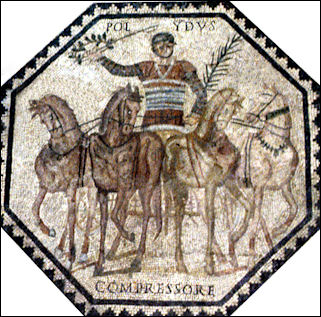
Roman chariot race
The wheel, some scholars have theorized, was first used to make pottery and then was adapted for wagons and chariots. The potter's wheel was invented in Mesopotamia in 4000 B.C. Some scholars have speculated that the wheel on carts were developed by placing a potters wheel on its side. Other say: first there were sleds, then rollers and finally wheels. Logs and other rollers were widely used in the ancient world to move heavy objects. It is believed that 6000-year-old megaliths that weighed many tons were moved by placing them on smooth logs and pulling them by teams of laborers.
Early wheeled vehicles were wagons and sleds with a wheel attached to each side. The wheel was most likely invented before around 3000 B.C — the approximate age of the oldest wheel specimens — as most early wheels were probably shaped from wood, which rots, and there isn't any evidence of them today. The evidence we do have consists of impressions left behind in ancient tombs, images on pottery and ancient models of wheeled carts fashioned from pottery."
Evidence of wheeled vehicles appears from the mid 4th millennium B.C., near-simultaneously in Mesopotamia, the Northern Caucasus and Central Europe. The question of who invented the first wheeled vehicles is far from resolved. The earliest well-dated depiction of a wheeled vehicle — a wagon with four wheels and two axles — is on the Bronocice pot, clay pot dated to between 3500 and 3350 B.C. excavated in a Funnelbeaker culture settlement in southern Poland. Some sources say the oldest images of the wheel originate from the Mesopotamian city of Ur A bas-relief from the Sumerian city of Ur — dated to 2500 B.C — shows four onagers (donkeylike animals) pulling a cart for a king. and were supposed to date sometime from 4000 BC. [Partly from Wikipedia]
In 2003 — at a site in the Ljubljana marshes, Slovenia, 20 kilometers southeast of Ljubljana — Slovenian scientists claimed they found the world's oldest wheel and axle. Dated with radiocarbon method by experts in Vienna to be between 5,100 and 5,350 years old the found in the remains of a pile'dwelling settlement, the wheel has a radius of 70 centimeters and is five centimeters thick. It is made of ash and oak. Surprisingly technologically advanced, it was made of two ashen panels of the same tree. The axle, whose age could not be precisely established, is about as old as the wheel. It is 120 centimeters long and made of oak. [Source: Slovenia News]
The wheel and axle were found near a wooden canoe. Both the wheel and the axle had been scorched, probably to protect them against pests. Slovenian experts surmise that the wheel they found belonged to a single-axle cart. The aperture for the axle on the wheel is square, which means the wheel and the axle rotated together and, considering the rough ground, the cart probably had only one axle. We can only guess what the cart itself was like. The Ljubljana marshes are a perfect place for old objects to be preserved. There have been many finds uncovered in this area. Apart from the wooden wheel, axle and canoe, there have been innumerable objects found which are up to 6,500 years old.
A wheel dated to 3000 B.C., was found near Lake Van in eastern Turkey. Wheels with simialr dates have been found in germany and Switzerland. One very old wheel was a wooden disc discovered at an archeological sight near Zurich. The wheel now can be seen in the Zurich museum.
See Separate Article ANCIENT HORSEMEN AND THE FIRST WHEELS, CHARIOTS AND MOUNTED RIDERS factsanddetails.com
Carts, Onangers and Horses
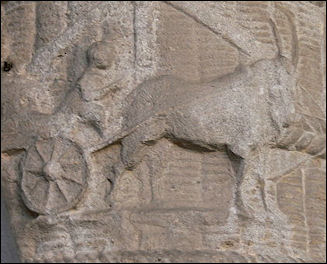
Roman chariot Animals pulling carts preceded mounted riders by as much as 2,000 years. A bas-relief from the Sumerian city of Ur, dated to 2500 B.C., shows four onangers (donkey-like animals) pulling a cart for a king. The first animals used to pull sledges (carts without wheels) were probably oxen (bulls made more docile by castration). The first carts were probably sledges with logs rolled underneath them.
Over time onangers and donkeys — animals that often will not move even when furiously whipped — were later replaced by horses who are less stubborn, faster, and have a lower threshold for pain than a donkeys. In the second millennia B.C. horses were increasingly to pull weights on the Central Asian steppes. These horses were smaller and shaggier than modern horses, and much more difficult to control than oxen. Deep-furrowed plows also began to be utilized by farmers in the second millennia B.C. Muscular oxen proved to be much better suited for this kind of work than horses.
Herdsman at this time had learned to breed sheep, goats, and cattle, and it follows that they applied what they learned about breeding to horses. Through breeding, horses were made manageable enough to attach to carts with the mouth-fitted bit . By contrast donkeys were controlled by reins attached to nose rings and oxen were harnessed to yokes shaped around their shoulders.
First Horse-Pulled Chariots
Chariots preceded mounted riders by at least 1,000 years. Because oxen were better suited for pulling plows and heavy loads, horses were attached to lighter vehicles that evolved into chariots. Lightweight chariots, employing technology similar to that used to make racing bicycles light, could move quite fast. Ancient Egyptian chariots, pulled by a pair of horses and weighing only 17 pounds, could reach easily reach speeds of 20 miles-per-hour. A cart pulled by oxen, by contrast, rarely exceeded two miles-per-hour.
Chariots preceded mounted horses and saddles in part because the early domesticated horses were small and not strong enough to support men on their backs. The first chariots were probably used by shepherds to help them hunt wolves, leopards and bears that threatened their flocks and were alter adapted for warfare.
The important elements of a chariot were the wheels, chassis, draught pole and metal fittings. Advancement in metallurgy, woodworking, tanning and leatherworking, the uses of glues, bone and sinew all made the construction of chariots possible but the most important development of all was the improvement in physique of horse to pull such a vehicle.
Travel by Water in the Roman Empire
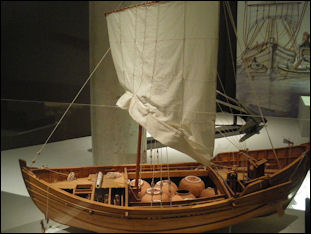
Roman transport ship Harold Whetstone Johnston wrote in “The Private Life of the Romans”: “The means of travel were the same as our ancestors used a century ago. By water the Roman used sailing vessels, rarely canal boats; by land, vehicles drawn by horses or mules; for short distances sedan chairs or litters. There were, however, few transportation companies, few lines of boats or vehicles, that is, few running between certain places and prepared to carry passengers at a fixed price on a regular schedule. [Source: “The Private Life of the Romans” by Harold Whetstone Johnston, Revised by Mary Johnston, Scott, Foresman and Company (1903, 1932) forumromanum.org |+|]
“The traveler by sea whose means did not permit him to buy or charter a vessel for his exclusive use had often to wait at the port until he found a boat going in the desired direction and then make such terms as he could for his passage. And there were other inconveniences. The boats were small, and this made them uncomfortable in rough weather; the lack of the compass caused them to follow the coast as much as possible, and this often increased the distance; in winter navigation was usually suspended.
“Traveling by water was, therefore, avoided as much as possible. Rather than sail to Athens from Ostia or Naples, for example, the traveler would go by land to Brundisium, by sea across to Dyrrachium, and continue the journey by land. Between Brundisium and Dyrrachium boats were constantly passing, and the only delay to be feared was that caused by bad weather. The short voyage, only 100 miles, was usually made within twenty-four hours. For a detailed and easily accessible account of an ancient voyage, see Acts, xxvii-xxviii. |+|
Roman Ships
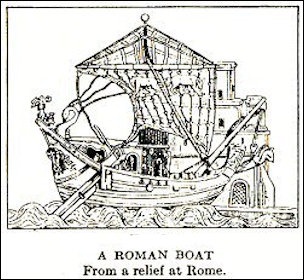
The Rome-Carthage trade ships were wooden vessels with square rigs and a deep belly which held amphoras filled with wine, olive oil, fish sauce and other goods. Planks were fastened together with hand cut mortise-and-tenon joints.
A number of Roman-era vessels have been excavated from the muddy ancient harbor of San Rossore in Pisa, They include merchant vessels, river boats and a warship described as the “the best-preserved vessel of antiquity ever found." The warship was preserved in 15 feet of mud and is practically undamaged. Some of the ships are on display on Pisa's new Museum of Ships.
A Roman trading ship dated to 200 B.C. that was found was 100 feet long and featured cargo holds in the fore and aft. It carried two lead anchors, bronze vessels and eight types of amphora (double-handed jars).
Items found on a ship dated to the time of Christ have indicated that trade took place between North Africa, southern France and Campania in southern Italy. First century A.D. ships have been found with cargos of granite stones, columns and a large anchor and amphorae carrying wine and oil. A fifth century ship has been found with iron anchors, hand-operated mill, a lamp from Carthage and Roman coins.
Large Roman Ships
Normal-size sea vessels held about 3,000 amphorae while large freighters held as many a 10,000. Grain was the main commodity, followed by wine and olive oil.
As time went the ships became larger and larger. Galleys rated as "fours," "fives," and "sixes" were introduced between 400 B.C. and 300 B.C. They were followed up by "16s," "20s" and "30s." The Emperor Ptolemy IV built a massive "40." The numbers refereed to the number pulling each triad of oars. Ships with more than three bank were built but ultimately they proved to be impractical.
Describing one of the largest boats, a 2nd century Greek wrote: "It was [420 feet] long, [58 feet] from gangway to plank and [72 feet] high to the prow ornament...It was double-prowed and double-sterned...During a trial run it took aboard over 4,000 oarsmen and 400 other crewmen, and on deck 2,850 marines."
In the late 1990s an English-Greek team built a 170-oar trireme at a cost of around $640,000. Held together with 20,000 tenons fastened with 40,000 oak pegs, it set sail with a an international crew of 132 men and 40 women. Describing, the team in action, Timothy Green wrote in Smithsonian, "the crew rowed together and sang together, getting up high spirits and up to seven knots.
Roman Ships Found Off Italy in the 2010s
In 2012, archaeologists said they found an almost intact Roman ship in the sea off the town on Varazze, some 18 miles from Genova, Italy. Rossella Lorenz wrote in discovery.com; “The ship, a navis oneraria, or merchant vessel, was located at a depth of about 200 feet thanks to a remotely operated vehicle (ROV) following tips from fishermen who had caught some jars in their nets. The ship sank about 2,000 years ago on her trade route between Spain and central Italy with a full cargo of more than 200 amphorae. [Source: Rossella Lorenz, discovery.com, August 20, 2012]
“Test on some of the recovered jars revealed they contained pickled fish, grain, wine and oil. The foodstuffs were traded in Spain for other goods. “There are some broken jars around the wreck, but we believe that most of the amphorae inside the ship are still sealed and food filled,” Lt. Col. Francesco Schilardi, who led the Carabinieri Subacquei (police divers), said.
“The ship, which dates to sometime between the 1st Century B.C. and the 1st Century A.D., is hidden under layers of mud on the seabed, which has left the wreck and its cargo intact. The vessel will remain hidden at the bottom of the sea until Italian authorities decide whether to raise it or not. “Right now the area of the finding has been secured, and no fishing or water traffic is allowed,” Lt. Col. Schilardi said.
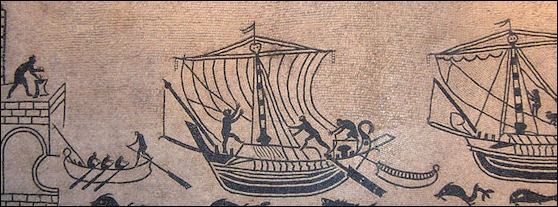
in 2010, A team of marine archaeologists using sonar scanners have discovered four ancient shipwrecks off the tiny Italian island of Zannone, with intact cargos of wine and oil. The remains of the trading vessels, dating from the first century B.C. to the 5th-7th century AD, are up to 165 metres underwater, a depth that preserved them from being disturbed by fishermen over the centuries. “The deeper you go, the more likely you are to find complete wrecks,” said Annalisa Zarattini, an official from the archaeological services section of the Italian culture ministry. [Source: Gulfnews.com, August 23, 2010 by Ancientfoods]
“The timber structures of the vessels have been eaten away by tiny marine organisms, leaving their outlines and the cargos still lying in the position they were stowed on board. “The ships sank, they came to rest at the bottom of the sea, the wood disappeared and you find the whole ship, with the entire cargo. Nothing has been taken away,” she said.
“The discoveries were made through cooperation between Italian authorities and the Aurora Trust, a US foundation that promotes exploration of the Mediterranean seabed. The vessels, up to 18 metres long, had been carrying amphorae, or large jars, containing wine from Italy, and cargo from North Africa and Spain including olive oil, fruit and garum, a pungent fish sauce that was a favourite ingredient in Roman cooking. Another ship, as yet undated, appeared to have been carrying building bricks. It is unclear how the vessels sank and no human remains have been found. The vessels are the second “fleet” of ships to be discovered in recent years near the Pontine islands, an archipelago off Italy’s west coast believed to have been a key junction for ships bringing supplies to the vast warehouses of Rome.
Roman Ship Loaded with Fermented Fish Sauce
In 2015, archaeologists announced that they had discovered a 25-meter-long ancient Roman vessel laden with 3000 jars garum – on the seabed off the coast of Alassio, in the northeastern Liguria region of Italy. “It’s an exceptional find that dates to the first or second century AD,” Dr. Simon Luca Trigona, who led the team, told The Local. “It’s one of just five ‘deep sea’ Roman vessels ever to be found in the Mediterranean and the first one to be found off the coast of Liguria. We know it was carrying a large cargo of garum when it sank.” [Source: AFP, December 11, 2015]
“In spite of the mystery that usually surrounds ancient shipwrecks, it is almost certain that the ship was sailing a route between Italy, Spain and Portugal in order to transport a precious cargo of Roman garum. The clue lies in the shape of the clay jars, as the sauce itself has all since seeped into the sea. “After we filmed the wreck and analyzed an amphora [clay jar] and some fragments that a robotic craft brought back to the surface, we realized the ship was carrying a huge quantity of fish sauce when it sank,” said Trigona. “The amphora are almost all of a certain type, which was used exclusively for garum.”
“In addition to the fish sauce, archaeologists also identified two types of jar which were only manufactured in the area around the river Tiber in Rome. It is thought they were probably being used to transport some of the area’s excellent regional wines to the Iberian peninsular. “It’s a nice find because it means we are almost sure about the route this ship was on,” Trugona said. “She most likely sailed out of Rome along the Tiber and sank a couple of weeks later while making the return journey, weighed down by all that fish sauce.”
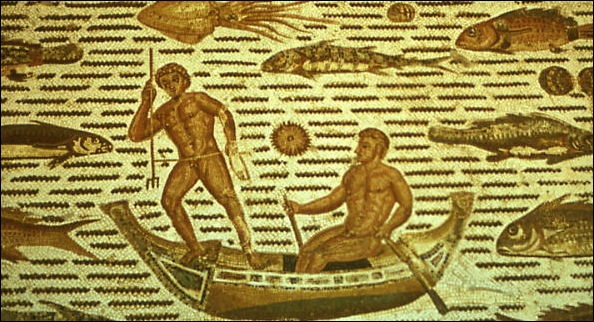
Evidence of Smuggling on a Roman Ship
In 2012, Italian archaeologists said they had uncovered evidence of smuggling between North Africa and Italy on a third-century A.D. shipwreck off the west coast of Sicily. Rossella Lorenzi wrote in Archaeology magazine: “The most complete Roman ship ever found, the 52-by-16-foot merchant vessel was carrying amphorae filled with walnuts, figs, olives, wine, oil, and fish sauce from Tunisia to Rome when it sank. [Source: Rossella Lorenzi, Archaeology, Volume 65 Number 4, July/August 2012 ^^^]
“Intriguingly, among the ship's official cargo were hidden stashes of so-called tubi fittili (fictile tubes). According to Sebastiano Tusa, Sicily's Superintendent of the Office of the Sea, "Basically they are small terracotta cylinders open at one end and closed at the other. Rows of these hollow tiles were used in vaulting and other construction." ^^^
“The tubes, which were used from the mid-Imperial era to the end of the Byzantine period, worked by fitting the narrow end, or nozzle, of one tile into the larger end of another. Because they were joined loosely, series of the lightweight tiles could be arranged in curves, making it easier to form arches and vaults. In North Africa, especially Tunisia, the valuable tubes were manufactured and cost a quarter of what builders paid for them in Rome. "To augment their poor salaries, sailors bought these vaulting tubes cheaper in Africa, hid them everywhere on the ship, and resold them in Rome," Tusa explains.” ^^^
Roman River Barge
Robert Kunzig wrote in National Geographic: “In the summer of 2004 a diver surveying the dump for archaeological riches noticed a mass of wood swelling from the mud at a depth of 13 feet. It turned out to be the aft port side of a 102-foot-long barge. The barge was almost intact; most of it was still buried under the layers of mud and amphorae that had sheltered it for nearly 2,000 years. It had held on to its last cargo and even to a few personal effects left behind by its crew. And through a further series of small miracles, including another intervention by Julius Caesar, it has emerged from the trash to resume its last voyage—safe this time in a brand-new wing of the Musée Départemental Arles Antique. [Source: Robert Kunzig, National Geographic, April 2014 ]
“To that snapshot of the boat, the nearly 1,200 cubic yards of mud and Roman trash that eventually buried it add a kind of time-lapse image of the commerce that was Arles. In the museum’s dim basement, Djaoui and I walked down long aisles of amphorae, many with their necks sliced off. “All this will have to be studied,” he said, with a trace of ambivalence. The dump is almost too rich; the archaeologists had already placed 130 tons of ceramic sherds back in the riverbed, in the hole left by the boat. I asked Djaoui about the building stones that had started the whole story. They were too heavy for the restored boat, he said; replicas were being used. Djaoui took me out behind the museum. The stones were there, next to a large trash bin, awaiting their own return to the river.
“When Arles-Rhône 3 sank, it was carrying 33 tons of building stones. They were flat, irregular slabs of limestone, from three to six inches thick. They had come from a quarry at St. Gabriel, less than ten miles north of Arles, and were probably headed toward a construction site on the right bank or in the Camargue, the marshy farmland south of Arles. The boat was pointed upstream, though, rather than downstream, indicating it had been tied up at the quay when it sank. A flash flood had probably swamped it.

Arles Rhone
“As the flood subsided, the cloud of sediment it had kicked up settled out of the water again, draping the barge in a layer of fine clay no more than eight inches thick. In that clay, in contact with the boat, Marlier and her team found the crew’s personal effects. A sickle they’d used to chop fuel for their cooking fire, with a few wood splinters next to the blade. A dolium, or large clay jar, cut in half to serve as a hibachi, with charcoal in the bottom. A plate and a gray pitcher that belonged to the same man—both bore the initials AT. “That’s what’s exceptional about this boat,” said Marlier. “We’re missing the captain at the helm. But otherwise we have everything.” The mast, with its traces of wear from the towropes, is to her the most precious find.
“Before that diving season was out, the same diver who had found Arles-Rhône 3, Pierre Giustiniani, discovered the statue that set the boat on its present course: a marble bust that looked like Julius Caesar. Portraits of Caesar are surprisingly rare. This one might be the only one extant that was sculpted while he was alive—perhaps right after he declared Arles a Roman colony, launching it into long centuries of prosperity.
Sudden Disappearance Of The Gateway To Rome
Heather Ramsey of Listverse wrote: “Between the second and sixth centuries, Portus was a valuable Roman harbor at the mouth of the Tiber River, where as many as 350 ships could dock at one time. Through Portus, the Romans received olive oil, wine, wheat, luxury goods, and slaves. This shipping hub was so important to them that they built one of their most elaborate palaces there, adorned with exquisite artwork such as mosaics and frescos and extending over several acres with walls up to 15 meters (50 ft) high. They also built an amphitheater and a massive warehouse, possibly for the construction and maintenance of ships for commerce and war. [Source: Heather Ramsey, Listverse, March 4, 2015 ]
“However, in the sixth century, as the Roman Empire was crumbling, the grand palace and massive warehouse were abandoned, with the structures appearing to vanish. By this time, the Roman Empire had been divided into two halves. With Byzantium (Constantinople) as its capital, the Byzantine Empire became its eastern half, fighting against marauders like the Ostrogoths to control Rome.
“Archaeologists from the University of Southampton, who are excavating the Portus site, have a theory as to what happened. “By the sixth century, the Byzantines felt the port could be a threat as it was vulnerable to being occupied by the Ostrogoths, so they took the decision to destroy it themselves,” said Simon Keay, who headed the dig. Rather than allow their enemies to dock in the great port, archaeologists believe the Byzantines flattened the structures, methodically pulling down each pillar and wall until nothing usable remained.”
Image Sources: Wikimedia Commons
Text Sources: Internet Ancient History Sourcebook: Rome sourcebooks.fordham.edu ; Internet Ancient History Sourcebook: Late Antiquity sourcebooks.fordham.edu ; Forum Romanum forumromanum.org ; “Outlines of Roman History” by William C. Morey, Ph.D., D.C.L. New York, American Book Company (1901), forumromanum.org \~\; “The Private Life of the Romans” by Harold Whetstone Johnston, Revised by Mary Johnston, Scott, Foresman and Company (1903, 1932) forumromanum.org |+|; BBC Ancient Rome bbc.co.uk/history/ ; Perseus Project - Tufts University; perseus.tufts.edu ; MIT, Online Library of Liberty, oll.libertyfund.org ; Gutenberg.org gutenberg.org Metropolitan Museum of Art, National Geographic, Smithsonian magazine, New York Times, Washington Post, Los Angeles Times, Live Science, Discover magazine, Times of London, Natural History magazine, Archaeology magazine, The New Yorker, Encyclopædia Britannica, "The Discoverers" [∞] and "The Creators" [μ]" by Daniel Boorstin. "Greek and Roman Life" by Ian Jenkins from the British Museum.Time, Newsweek, Wikipedia, Reuters, Associated Press, The Guardian, AFP, Lonely Planet Guides and various books and other publications.
Last updated October 2018

